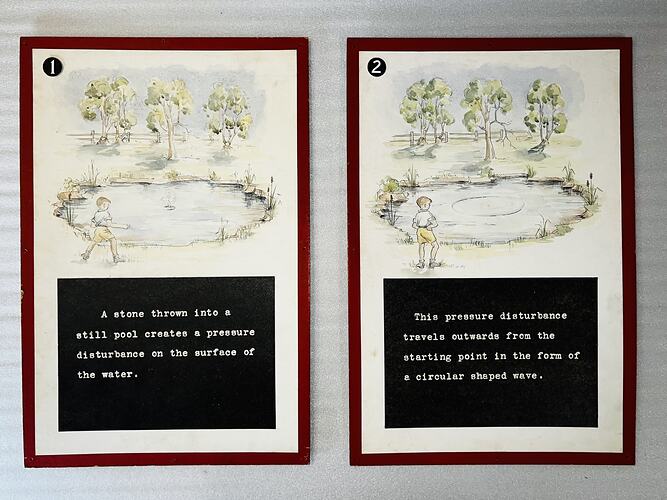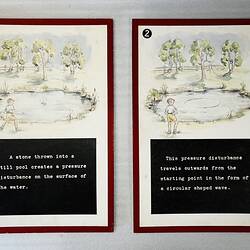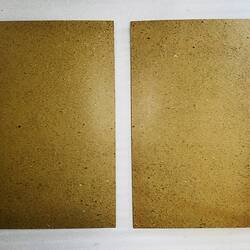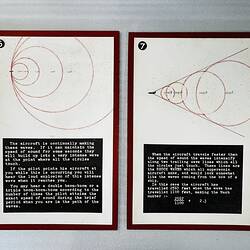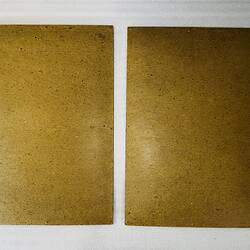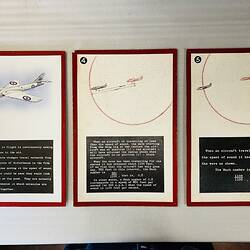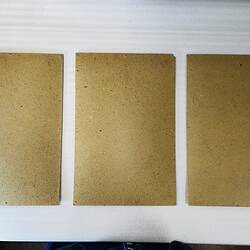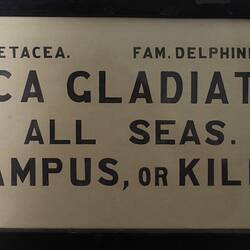Summary
This series of seven didactic exhibition labels from the Museum of Applied Science illustrates the unseen forces of pressure disturbance, circa 1950.
It employs three graphic panels to explain pressure disturbance in liquid and air and a further four graphic panels to illustrate pressure waves in air using aircraft travelling at the speed of sound. Each panel is hand painted and inked with printed text panels beneath. Each is numbered 1 through to 7.
Significance
The labels in the Historic Exhibition Labels Collection illustrate the changing styles in didactic interpretation, aesthetics and approaches to audiences engagement throughout the history of Museums Victoria. From the earliest days of the National Museum of Victoria in the mid 1800s through the various incarnations of the Applied Sciences collection through to the amalgamation of all branches into Museums Victoria, the labels chart a course through changes in audience needs and desires and across the museums various sites. There are beautiful examples of hand written nineteenth century labels, some examples of extremely long didactic panels from the early twentieth century and rare and unusual fonts in the mid twentieth century. The collection also illustrates the transition from hand-written labels to the use of typewriter, then Letraset and ultimately printed labels, culminating in the large format digital print room being introduced at Melbourne Museum in 2000.
More Information
-
Collection Names
-
Collecting Areas
Museum History, Information & Communication, Public Life & Institutions, Medicine & Health
-
Creator
Museum of Applied Science of Victoria, Victoria, Australia, circa 1950
-
Inscriptions
A stone thrown into a still pool creates a pressure disturbance on the surface of the water. / This pressure disturbance travels outwards from the starting point in the form of a circular shaped wave. / An aircraft in flight is continuously making pressure changes in the air. / These pressure changes travel outwards from the initial points of disturbance in the form of circular waves moving at the speed of sound. / If the waves could be seen they would look like the waves on the pond. / They are actually zones of compression in which molecules are forced closer together. / When an aircraft is travelling at less than the speed of sound, the wave starting from the wing tip at the instant the aircraft was at position / (1) - red aircraft - will have attained the radius shown when the aircraft is in position / (2) - black aircraft. / When the wave has been travelling for one second it has advanced about 1100 feet. / If we find that the aircraft has only gone say, 880 feet in this interval, the Mach number is 880/1100, that is, 0.8 / In other words, a Mach number of 8.0 corresponds to a speed of 880 feet per second (or 600 m.p.h.) when the speed of sound is 1100 feet per second. / When an aircraft travels at exactly the speed of sound it keeps up with the wave as shown. / The Mach number in this case is 1100/1100, or 1.0 / The aircraft is continually making these waves. If it can maintain the speed of sound for some seconds they will build up into a very intense wave at the point where all the circles touch. / If the pilot points his aircraft at you while this is occuring you will hear a loud explosion of this intense wave when it reaches you. / You may hear a double boom-boom or a triple boom-boom-boom according to the number of times the pilot attains the exact speed of sound during the brief period when you are in the path of the waves. /
-
Classification
-
Category
-
Discipline
-
Type of item
-
Object Dimensions
460 mm (Length), 300 mm (Width)
Dimensions are the same for all seven labels
-
Keywords
Exhibitions, Burns, Museum Display Panels, Museum Exhibitions, Museums, Physics, Aircraft
